Art History African Art
1/16
There's no tags or description
Looks like no tags are added yet.
Name | Mastery | Learn | Test | Matching | Spaced |
|---|
No study sessions yet.
17 Terms
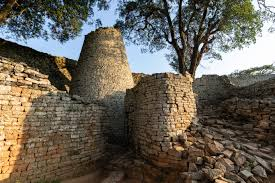
“Conical Tower of Great Zimbabwe” Shona People, 1000 CE, Granite
Visuals: Built W/O mortar (like Nan Madol), Locally hewn stone (built from local stone) → makes it more attractive as a trade site; local stones look nice, Walls built high for visibility not defence, 250 royal houses (again, similar to Nan Madol)
Context: Leader distributed grain as a symbol of protection, 20,000 inhabitant, Monolithic bird sculpture (excavted at site) → symbol of KING & DIVINE RULE/POWER
Function: Royal residence, Commercial trade site, Granary (store grain, silo) = symbol of trade, success, and power
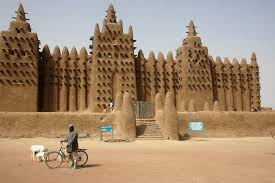
“Great Mosque of Djenne” Mali, Founded 1200 but Rebuilt 1906, Adobe (mud brick, more of a Mali thing)
Function: Mosque (sacred part) AND trading center (domestic part) - sacred spaces are dark, Creppisage Festival (ritual for replasting, everyone is involved)
Visuals: TORONS - decorative & sculptural (nubs/stick outs) → climb up these for festival to replaster, rectilinear building (consisting of straight lines), mud brick, pillars w/ ostrich egg = fertility, Minarets = tower to call to prayer, Mihrab & Qibla, points toward Mecca → guides prayer direction
Context: Built by first converted African Chief in oldest day, Rebuilt 3x, Tombs of Muslim scholars nearby (like Stonehenge)
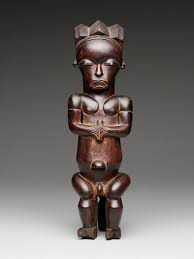
“Byeri Reliquary Figure” Fang people, Cameroon, 19th century, Wood
Visuals: a RELIC = object used to contain person’s remains, CALM expression (nonchalant), Infant body and adult head represents the CIRCLE OF LIFE, elaborate hairstyle (represented power), wood surface and polsihed with oil, emphasis on belly button (gives life; umbilical cord), Rigid (still, stiff, unmoving)
Context: NOMADIC tribe, venerates (worships) ancestors, only viewed by initiated men (young men & women could not peek into), placed on TOP of basket of ancestors remains
Function:LINK between living and dead, commmune with ancestors (AXIS MUNDI - spiritual connection from heaven to Earth), EDUCATES young men being initiated (like the Navigation Chart), protect ancestor remains
CONTEXT: spiritual belief FUNCTION: ritual practice
ancestors live on in afterlife → worship dead relatives
ancestors hold power over tribe → honor them by protecting remains
TRIBE IS NOMADIC → Ancestor remains in PORTABLE vessel
Characteristics of RELICS
Figural (represent people) sculpture
Rigid/seated/still → standing guard
Symmetrical → stability, balance
Calm/Serious Face → Transcendent
Shiny surface → polished, ritual use
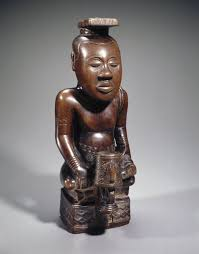
“Ndop of King Mishe” Kuba people, DR Congo, 19th century, Wood and Metal
VISUALS: large head emphasizes his wisdom and intelligence - he thinks things through, Highly polished, nat’l mat’l, contemplative expression, seated in meditation - introspective king, belly + lack of muscle *PEACEFUL, Dagger of Peace- turned away, Hand out to receive advice
Context: ORAL HISTORY - Mishe known for his generosity and received his own praise song, created during life to document accomplishment, POSTHUMOUSLY - educate new king, kept around to document history
Function: container of SPIRIT and document HISTORY
SPIRITUAL BELIEF → RITUAL PRACTICE
Spirits float in “Purgatory” until finding afterlife/Heaven → Build a container (artwork) to house spirit TEMPORARILY (like Malangan, except Malangan was thrown away after, Ndop was not)
King still watch over tribe after death (like Moai) → Ndop “educates” new leader, feed and house sculpture until no longer needed
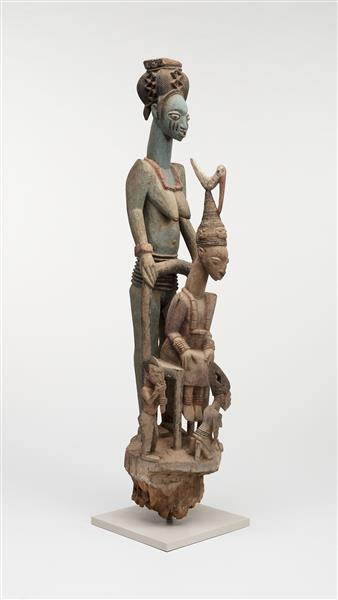
“Veranda Post” Artist: Olowe of Ise, Yoruba, 20th cent., Wood & Pigment
Visuals: Ogoga- KING (most powerful person shown), bird (hat) = protection by female ancestors; INNOVATIONS - Painted for decoration, negative space, multiple figures (*HIERARCHY)
Context: Holds up entrance porch to palace, oral history, OLOWE - famous carver for having OJUANA (ability to tell stories with art)
Function: SHOW POWER
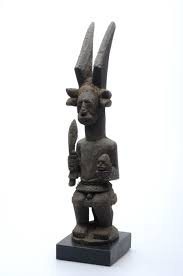
“Ikenga Figure” Igbo people, 19th-20th century, Wood
Visuals: Ram horns = determined/represents determination, stylized, right hand of accomplishment
Context: Male dom. society
Function: Individual possession (every male has their own), supernatural power (chi)
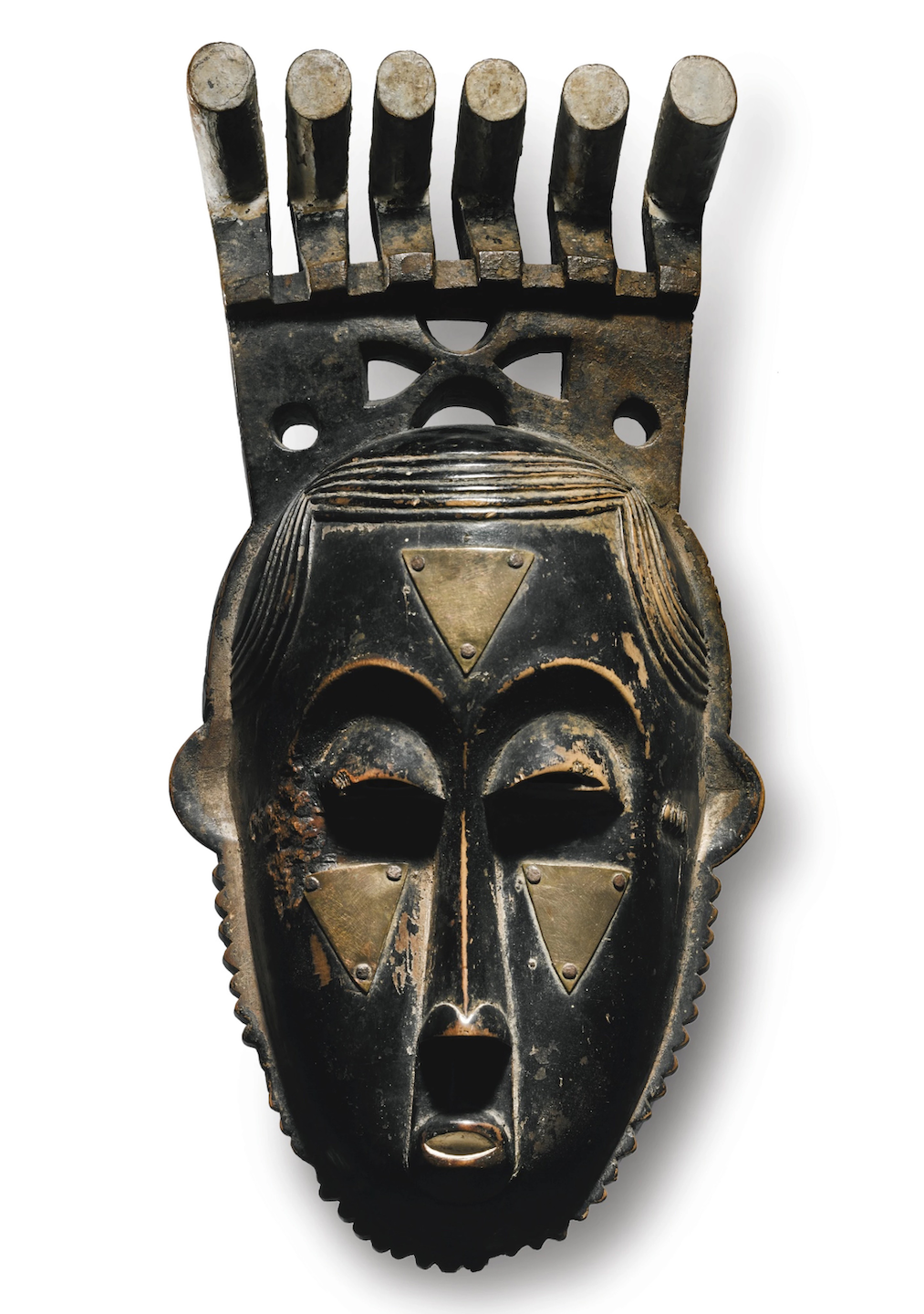
“Mblo Portrait Mask” carved by Owie Kimou, Baule people, Cote d’Ivoire, 20th century, wood, brass, and pigment
Visuals: Portrait of Moya Yanso, Brass triangles = shiny & represents healthy, wrinkles by mouth = age/wisdom, high forehead = intelligence, slit eyes = modesty, elaborate hairstyle = beauty
Context: Matriarchal society (run by women), COMMISSIONED BY HUSBAND
Function: Performed by Moya (known for dancing), later by stepson Soule, personal achievement
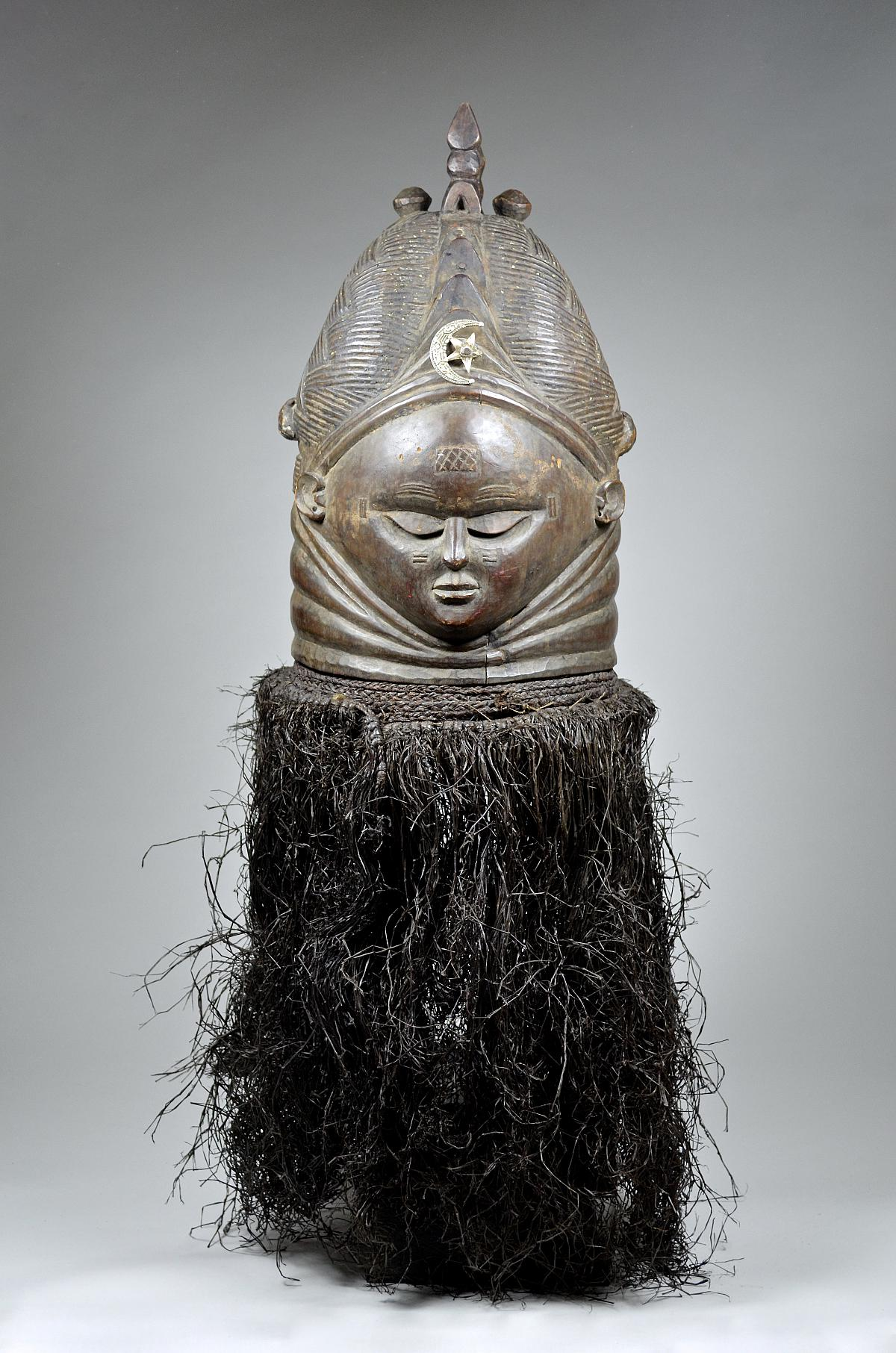
“Bundu Mask” Sande Society, Sierra Leone, 20th century, Wood, cloth, and Fiber
Visuals: smooth, dark surface (polished, used in ritual), Ripples = COULD BE.. 1) symbol of fertility 2) representation of the water spirit, high forehead = wisdom/intelligence, small closed mouth = woman who doesn’t gossip (ideal), downcast eyes = modesty/respect, elaborate hairstyle = beauty
Functio: performed at coming of age ceremonies for females in Sande Society, MODELS IDEAL female appearance AND behavior
Context: uninitiated girls painted white (unattractive), mask is worn on top of head → raffia covers performer - allows spirit to embody performer
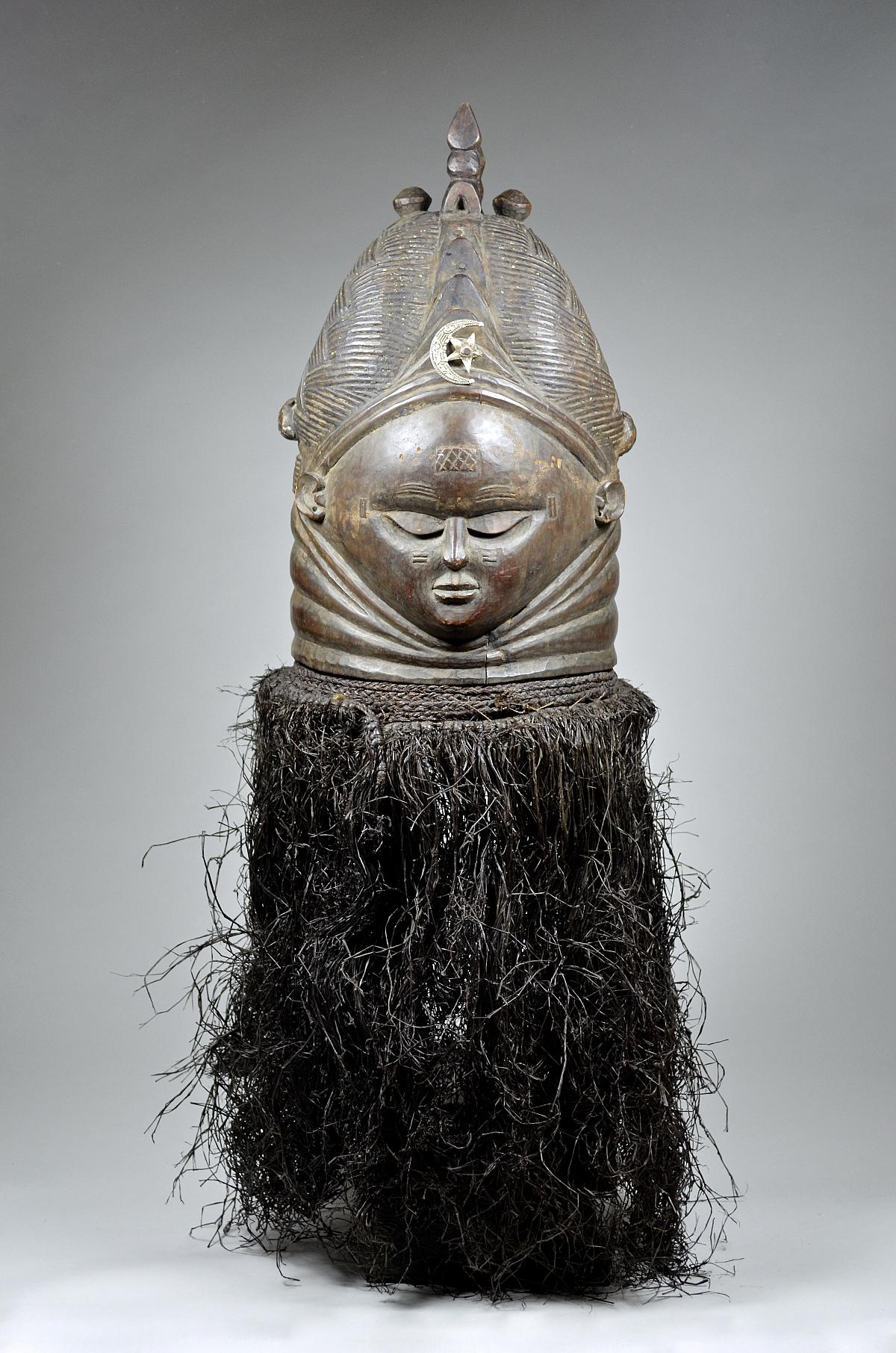
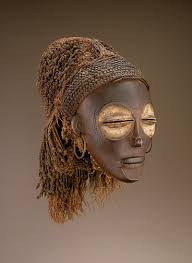
“Pwo Female Mask” Chokwe people, DR Congo, 19th century, wood/fiber/brass/paint
Context: Patriarchal & matrilineal society (men are most powerful, but inheritance, kinship, and status traced through female side/mothers side), women revered BUT controlled, represents a female deity that has successfully given birth
Visuals: White around eyes - represents spirit realm, dots around eyes = tears (sad becuase bond w/ son ends), represented ideal womanhood (beauty - hair, slit eyes - respect, long nose), symbols of power = METAL earrings, hair, white eyes (shows status)
Function: Performed by MEN; an HONOR to do so, ends bond btwn mother and son (son can now marry & becomes above mother, enters patriarchy), male initiation - how to treat women and how to act properly
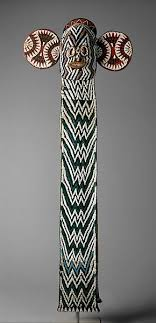
“Aka Elephant mask” Bamileke ppl, Cameroon, 19th century
Visuals: Beads imported from Venice = shows wealth and status (social power), Black = living & dead connect, White = ancestors & medicine, Red = life & women (fertility), Triangles = leopard; authority
Context & Function: reinforced SOCIAL & POLITICAL power, performed ONLY by elite, Began in palace; entered courtyard marketplace, recreate power of elephant to reinforce power of Bamileke king (dom)
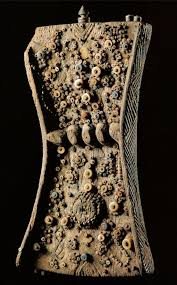
“Lukasa Memory Board” Luba people, DR Congo, 20th century, Wood, beads, metal
Context: no written language, emphasis on oral history and TRADITION; Mbudye group - preserve royal history
Function: Mneumonic device: trace w/ fingers to read, interpret, and transmit social knowledge
Visuals: Abstract, hand-held, largest bead = king, lines = travel, trade, white bead/shell=spirit world (Pwo Mask)
Historical Context: court procedure, royal events, political opinions
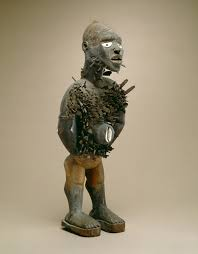
“Nkisi Power Figure” 19th century; DR Congo; Kongo people; Wood, pigment, Metal
Function: Settle disputes and cure sickness (PLACEBO)
Nails - influenced by crucifixion storiees from Christian missionaries, believed to contain Jesus’ supernatural power
EMPHASIS on the BELLY BUTTON - represented life-giving force; contained a lot of medicine (cure sickeness)
Figure Built by artist, activated by Nganga (priest)
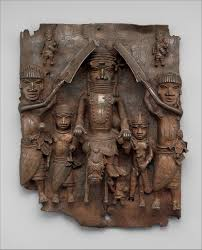
“Wall Plaqure from Oba’s Palace” Edo People, Benin (NIgeria in modern day), 16th century, Cast Brass
VISUALS: LOST WAX BRONZE CASTING - new industrial technique used to create → shows the king as INNOVATIVE, Oba (king) on a horse with attendants, HIERARCHY OF THE INDIVIDUAL (seated, largest, center), Portuguese textile in the background
Context and Function: Golden age of “urbanization” → to impress world leaders, End of indigenous expression and begins trade, Commemorates trade w/ Portugal → establishes political power, placed on walls of palace, audience → visiting dignitaries (impt. high-statues people)
PUNITIVE EXPEDITION OF 1897: Benin is colonized, Oba is exiled, art is looted
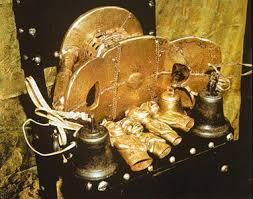
“Ashanti Golden Stool” Ghana; 18th cent.; Wood & Gold Leaf
(Oral History): In early 1700s, high priest summoned/conjured golden stool & it fell from sky to EARTH
KING cared for the stool (King has the ONLY gold stool, not meant to be sat on)
Everyone had their own stool; showed STATUS (more money = nice); only ONE GOLDEN (KING’S)
ONLY displayed on the side
Bells of ancestors → rung to call forth wisdom of ancestors
Displayed on TOP of leopard pelt → shows DOMINANCE over nature
After a major war it was placed on top of British chair (they won against the British) → shows DOMINANCE over British
Stool always next to King & consulted primarily in war councils
CONTEXT BELIEF: Stool contained the soul of the ENTIRE nation
Ghana known for their gold & Kente cloth (shows status)
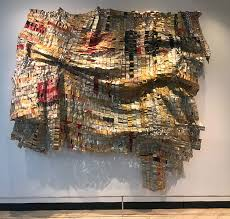
“Old Man’s Cloth” Aluminum & copper wire; El Anatsui (artist); 2003
Site based, Kinetic (moving) installation → changes form from location to location
Hung to look like fabric (Kente Cloth)
Trans-Atlantic Slave Trade
damaged the culture (alcohol, takes slaves)
Creation through destruction → used discarded items to create art
NEW art tools! → metals, hammers
Gold = Ghana, Gold Coast, ASHANTI
Recycling of culture → good can come from the bad
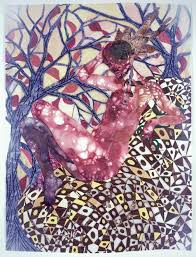
“Preying Mantra” 2006; Wangechi Mutu (artist); Mixed Media on mylar
Wangechi Mutu = female, born in Kenya, educated in EU. & US
Violence or colonization of Kenya, espeically women; *SEXUAL TOURISM (Gave STDs to the women)
Collaged materials (like collaging cultures)
Pornography
Medical Journals
Fashion Magazines
Reclined female - Male, Euro. gaze
Praying Mantis - consumes male as prey
Patterns camouflage the female like a predator